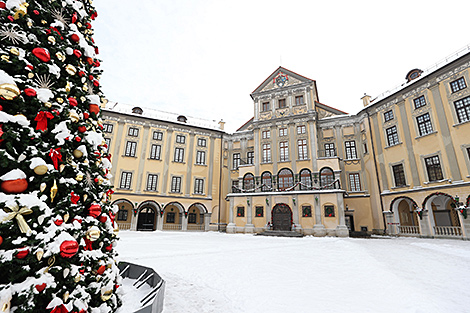Year of People’s Unity
Meeting with large families opens Year of People’s Unity in Belarus

NESVIZH DISTRICT, 22 January (BelTA) - A national open dialogue "Large family as the priority of the state family policy" is running in the National Historical and Cultural Museum-Reserve at Nesvizh, BelTA has learned.
Twenty large families from all regions of the country have been invited to the meeting. Among the participants are parents of three, four, and five children. Not only birth children. For example, the Kuzmin family has six children, three of them adopted. The largest family among the participants is the Mikhaltsov family. They said that they see the meeting as an opportunity to discuss, on behalf of all parents, the government family policy and to work out proposals on how to improve it.
Welcoming the participants of the meeting, Deputy Prime Minister Igor Petrishenko noted that it is symbolic that the Year of People’s Unity has started with a wide-ranging dialogue with large families. He also suggested organizing a series of excursions to Nesvizh Castle for families with children in spring-summer. "In the Slavic tradition, it was a large close-knit family that symbolized the soundness and stability, the depth of ancestral roots, and hence the vitality of the people, the strength of the state system," he said.
In his welcoming speech Metropolitan Veniamin of Minsk and Zaslavl, Patriarchal Exarch of All Belarus, noted that a demographic crisis in the country has drawn much attention to the topic of family values. “Before borrowing from foreign experience we should not neglect the large family traditions, the resources and initiatives of the church and the public that cultivate responsible parenthood and marital fidelity,” he said.



Belarus’ Labor and Social Security Minister Irina Kostevich noted that there are more than 112,000 large families in Belarus today. Their number is growing: since the launch of the family capital program, the number of third and subsequent children born every year in Belarus has exceeded 20,000. As of today more than 93,000 family capital deposit accounts have been opened, and many families are actively using this resource ahead of schedule, especially to improve housing conditions. "Measures to support families with children are multifaceted," the minister said. Funding for 2021 alone will exceed Br5 billion, of which about Br2.7 billion will be spent on state benefits for families with children.
First Deputy Healthcare Minister Yelena Bogdan spoke about the current achievements in the field of maternity and child care. Deputy Education Minister Aleksandr Kadlubai spoke about the development of preschool childcare services.
The meeting in Nesvizh is the final event in a series of discussion platforms with large families held in all regions of Belarus in December-January. At the start of this campaign, it was mainly mothers with many children who took an active part in the discussion meetings. Very soon fathers joined too, Irina Kostevich noted. “This is great. If we are talking about a strong family, this means equal responsibility,” the minister said.
The topic of responsible fatherhood was also raised during the discussion. The participants discussed family-work balancing, measures to expand and differentiate social assistance to families, additional areas for early use of the family capital. Participants of the meeting also expressed support for extending this measure to the birth of a second child. The main topic on the agenda were the ways to increase the birth rate. The goal is difficult to achieve this for objective reasons today. There are fewer women of fertile age now, because the total fertility rate (number of children per woman) has been low since 1995, the year when it reached a historic low of 1.25 (the highest was in 1958 – 2.77; simple reproduction requires 2.1). Thus, a so-called demographic hole was formed. Today it is of utmost importance that Belarusian families give birth to more children and that the very institution of the family get stronger.
“I think the whole problem is in people's heads,” said Irina Sidor, a mother of three from the agrotown of Lunno, Grodno Oblast. “Many young people, married couples just look for an excuse and postpone having children: too busy working, studying, not enough money, etc. Then another reason emerges - health. Unfortunately, not everyone who would like to be a parent succeeds. When we had our third daughter, it was a little scary at first, but now we are very happy. My husband and I are trying to set an example for others that a big family is great,” he said.
The event at Nesvizh was organized by the Labor and Social Security Ministry jointly with the Minsk Oblast Executive Committee.







 print version
print version make home page
make home page add to bookmarks
add to bookmarks

